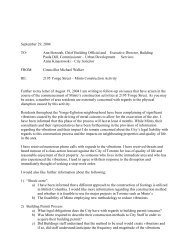Residential Tenancy Reform Consultation Paper
Residential Tenancy Reform Consultation Paper - Michael Walker
Residential Tenancy Reform Consultation Paper - Michael Walker
You also want an ePaper? Increase the reach of your titles
YUMPU automatically turns print PDFs into web optimized ePapers that Google loves.
Appendix A:<br />
Overview of Ontario’s private rental market<br />
RESIDENTIAL TENANCY REFORM CONSULTATION PAPER<br />
Approximately 1.1 million tenant households rely on<br />
the private rental market to meet their housing<br />
needs. Another 250,000 renter households occupy social<br />
housing units.<br />
Rental production<br />
The development of new rental housing, since the early<br />
1970s, has been generally unattractive to the private sector<br />
as returns on alternative investments, including condominiums,<br />
have been higher. New private rental construction<br />
starts dropped to 550 units in 1995, the lowest recorded<br />
level, having peaked at almost 40,000 units in 1972. The<br />
changes in the federal tax treatment of rental investment<br />
in the early 1970s were one of the main reasons for the<br />
decline in rental starts 6 . The effect of removing some of<br />
the barriers to new private rental housing and making<br />
improvements to the business conditions for rental housing<br />
is beginning to be seen. Private rental housing starts in<br />
Ontario, while continuing to be low by historical standards,<br />
have increased to nearly 4,800 units in 2003 compared to<br />
1995.<br />
Private Rental Starts in Ontario<br />
Starts<br />
500000<br />
400000<br />
300000<br />
200000<br />
100000<br />
0<br />
1970<br />
Source: MMAH estimates based on CMHC data<br />
1973<br />
1976<br />
1979<br />
1982<br />
1985<br />
1988<br />
1991<br />
1994<br />
1997<br />
2000<br />
Secondary rental market<br />
Conventional purpose built rental production is supplemented<br />
by the secondary sector. The secondary rental market,<br />
which includes tenant-occupied single, semi and row<br />
6. Lampert, Greg. (1995). Discussion <strong>Paper</strong>: The Challenge of Encouraging<br />
Investment in New Rental Housing in Ontario. Ministry of Municipal<br />
Affairs and Housing.<br />
2003<br />
dwellings, rented condominium units, accessory apartments<br />
such as self-contained basement units and flats (legal and<br />
illegal) and apartments over stores, contain some of the<br />
more affordable rental housing. The secondary rental market<br />
is an important component of overall rental supply.<br />
A 1998 report by Starr Consulting Inc., titled The Secondary<br />
Rental Market, found that the secondary sector represented<br />
36 per cent of the overall rental supply in the City of<br />
Toronto, 73 per cent in the suburban GTA, and between<br />
43 per cent to 55 per cent in other centres like Ottawa,<br />
Hamilton, Kitchener-Waterloo, Windsor and Sudbury. It is<br />
estimated that more than 100,000 houses in Ontario have<br />
basement apartments and other forms of accessory units.<br />
Another study by Canada Mortgage and Housing Corporation<br />
(CMHC) on rented condominiums estimated that 19<br />
per cent (33,838 units) of all condominiums in the GTA<br />
were rented out in 2003.<br />
The secondary rental market is, however, a less secure<br />
source of rental housing than purpose-built rental housing.<br />
The sustained availability of secondary rental market housing<br />
depends heavily on economic and real estate conditions<br />
and thus cannot be counted on for long-term supply.<br />
Vacancy rates<br />
Vacancy rates for private rental units have increased significantly<br />
over the past two years. According to CMHC,<br />
Ontario had an average vacancy rate of 3.5 per cent in<br />
October 2003, compared to 2.7 per cent in October 2002<br />
and 1.7 per cent in 2000. CMHC’s survey is not conducted<br />
in areas with a population of less than 10,000 nor does it<br />
include units in the secondary rental market. Vacancy rates<br />
in Toronto and Ottawa Census Metropolitan Areas (CMAs)<br />
were 3.8 per cent and 2.9 per cent, respectively, compared<br />
to 2.5 per cent and 1.9 per cent, respectively, in 2002.<br />
Other major urban centres also had relatively high vacancy<br />
rates including Windsor (4.3 per cent), Kitchener (3.2 per<br />
cent), Hamilton (3.0 per cent) and St. Catharines (2.7 per<br />
cent). Kingston has a relatively lower vacancy rate (1.9 per<br />
cent in 2003). A vacancy rate of 2-3 per cent is conventionally<br />
considered to be representative of a balanced market.<br />
32






